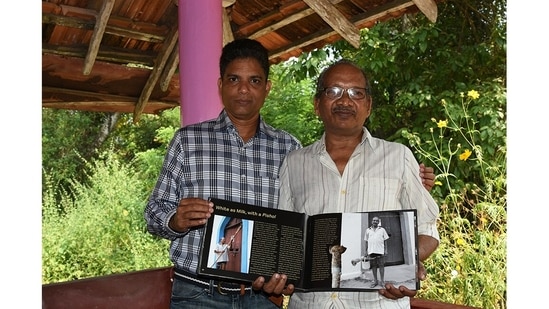Photos: Ancient Goa through the eyes of photographer Pantaleão Fernandes
Published on Mar 04, 2022 03:16 PM IST
- Eighteen years ago, Pantaleão Fernandes, a civil engineer, quit his construction business to explore the villages of Goa and pursue his passion for photography. Since then, he has published seven books chronicling lesser-known aspects of Goan culture and heritage, including ancient artefacts from prehistoric tombstones to religious statuary.
1 / 7

Published on Mar 04, 2022 03:16 PM IST
This stone icon with a decorative panel depicting the goddess Gajalakshmi sits in a sacred grove in Kudshe village, Sattari. It finds mention in photographer Pantaleão Fernandes’s latest book, Outdoor Museums of Goa, which focuses on forgotten historical artefacts that dot the state. (Photo courtesy Pantaleão Fernandes)
2 / 7

Published on Mar 04, 2022 03:16 PM IST
Fernandes (L), seen here with traditional painter Mario Ratos from Benaulim, quit his construction business 18 years ago to tour Goa’s villages and pursue his passion for photography. He has since published seven books showcasing his work. Ratos featured in his 2015 book, Traditional Occupations of Goa. (Photo courtesy Pantaleão Fernandes)
3 / 7

Published on Mar 04, 2022 03:16 PM IST
Fernandes spotted this dolmen, a prehistoric tombstone consisting of three vertical megaliths topped by a horizontal one, near a temple in Agonda in South Goa. Despite being a marker for important ancient graves, the dolmen wasn’t protected and not many locals knew its significance, he says.(Photo courtesy Pantaleão Fernandes)
4 / 7

Published on Mar 04, 2022 03:16 PM IST
A hero stone commemorates the bravery of a local man who died trying to safeguard his village, Pedem in Canacona. The lower panels show the elaborate funeral of the village hero while the top panel is dedicated to goddess Gajalakshmi, flanked by two elephants. (Photo courtesy Pantaleão Fernandes)
5 / 7

Published on Mar 04, 2022 03:16 PM IST
Sati stones serve as memorials to women who committed the traditional self-immolation following the death of their spouse. Local legend has it that this stone was erected in memory of a local queen, who set herself on fire after she learnt of her husband’s death. Her ashes were immersed in the Kushawati river, on whose banks this stone was erected. (Photo courtesy Pantaleão Fernandes)
6 / 7

Published on Mar 04, 2022 03:16 PM IST
Petroglyphs or rock carvings at Sanguem in South Goa. Some date to 8000 BCE. “These petroglyphs are carved into laterite stone and depict animals such as bulls, deer, bison, as well as human figures and a woman dancing. Most visitors have no idea these are here, along the Kushawati river, and walk right past them,” Fernandes says. (Photo courtesy Pantaleão Fernandes )
7 / 7

Published on Mar 04, 2022 03:16 PM IST



